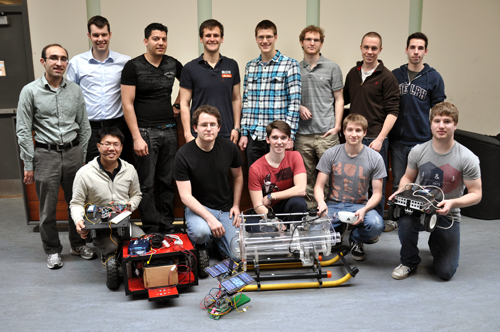
For members of the U of G robotics team, the gears are always turning – both literally and figuratively. Established by engineering professor Mohammad Biglarbegian in 2011, the team achieved official U of G club status in January 2012.
Biglarbegian says the students “get a lot of hands-on experience developing mechatronics systems,” which allows them to apply the mechanical, electrical and computer engineering skills they learn in their classes. When he joined U of G, he saw a lot of potential in its engineering students and a strong interest in robotics, which happens to be his field of research (he also teaches a course on mechatronics). “I enjoy interacting with the students. They’re very hard-working and enthusiastic.”
The team spent the past year working on an entry for the annual Intelligent Ground Vehicle Competition in Rochester, MI, in June. The U of G robot, which is three by four by five feet, will race other vehicles through an obstacle course the size of a football field. Controlled by a laptop, the robot uses GPS, laser sensors and a camera to move around obstacles.
The students also built an underwater robot, putting to the test skills they learned in a second-year fluid dynamics course. Building a robot that can operate entirely underwater is more challenging and requires different types of materials than a land-based robot. The mechanical properties of the materials, for example, determine how deep the robot can travel underwater. Equipped with cameras and lights, the remote-controlled robot is currently being tested on a tether until it becomes fully automated.
The students usually build the robots from scratch, but sometimes the team modifies partially assembled parts. Putting theory into practice gives students real-world experience: a motor that looks good on paper might not be the best choice for a particular application. They also learn how to build mechanical systems, program macro-controllers and work with sensors. “I really like the opportunity to work with more advanced technology,” says Pat Griffin, a fourth-year mechanical engineering student.
The junior robotics team, established last fall, attracts first- and second-year students. “We teach them to learn how to put things together and design and manufacture a robot,” says Biglarbegian.
Aside from the technical skills involved in building a robot, students also develop interpersonal skills such as teamwork and communication. Each student has strengths in different areas, and they can help each other learn more about their respective disciplines. “This is a very multidisciplinary area, because you have mechanical, electrical, computing and programming involved,” says Biglarbegian. “They must work together to learn from each other and transfer their knowledge from one to another.”
Working in a team also helps prepare them for the real world, where they will be required to work with people from different backgrounds, says the team’s leader, Jonathan Walsh, a fourth-year mechanical engineering student. “You need people from different disciplines, and you need to be able to interact with them,” he says. “If you’re not able to, it’s just going to fall apart. The electrical might not work; the mechanical might not work.” The robot’s parts need to work together – much like the team itself – and if one part doesn’t work, the whole system fails.
“A lot of courses overlap,” adds Josh Braven, also a fourth-year mechanical engineering student. “Someone in engineering systems and computing knows a lot more about programming, and someone in mechanical knows a lot more about the structure, the motors or electricity.”
Although the club consists mostly of upper-year undergraduate students in computer engineering, mechanical engineering, and engineering systems and computing, students in any program may join, even if they have no engineering background. Business students, for example, have helped the team develop marketing materials and sponsorship opportunities.
The team has displayed robots at College Royal, and has been asked to do a robotic ribbon-cutting at the opening of the School of Engineering expansion in October.
For more information, visit www.uoguelph.ca/~ugrt/team.html or email ugrt@uoguelph.ca.